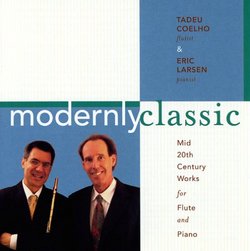| All Artists: Tadeu Coelho, Burton, Prokofiev, Copland, Poulenc, ect Title: Modernly Classic: Mid 20th Century Works for Flute and Piano Members Wishing: 1 Total Copies: 0 Label: Tempo Primo Enterprises Release Date: 7/31/2006 Genre: Classical Style: Number of Discs: 1 SwapaCD Credits: 1 UPC: 837101208697 |
Search - Tadeu Coelho, Burton, Prokofiev :: Modernly Classic: Mid 20th Century Works for Flute and Piano
 | Tadeu Coelho, Burton, Prokofiev Modernly Classic: Mid 20th Century Works for Flute and Piano Genre: Classical
The works compiled in this present CD were composed between 1936 and 1971. The period in question is by no means a homogenous one; styles were as varied as the number of composers. The five composers Poulenc, Prokofiev, ... more » |
Larger Image |
CD Details
Synopsis
Product Description
The works compiled in this present CD were composed between 1936 and 1971. The period in question is by no means a homogenous one; styles were as varied as the number of composers. The five composers Poulenc, Prokofiev, Copland, Hindemith, and Burton intersect in interesting ways. With the exception of Burton, they all were in Paris during the middle of the twentieth century and either directly or indirectly became influenced by the music of Stravinsky, the ballets of Diaghilev, and the teachings of Nadia Boulanger. Hindemith and Prokofiev took refuge in the United States during the war years (incidentally, Madame Boulanger was also a war refugee in the US from 1941-43, where she frequently lectured at Harvard School as a guest of Professor Paul Hindemith). The most isolated of the five was the lesser-known Burton. Born and raised in the US, he first studied in his native Georgia and later undertook some studies at the Juilliard School in New York. However, all of these composers saw themselves as both classic and modern. Classic, because most of them were writing works in sonata form and were using as their models the composers of the eighteenth and nineteenth centuries; modern, because each had a new and unique approach to harmony.

 Track Listings (17) - Disc #1
Track Listings (17) - Disc #1